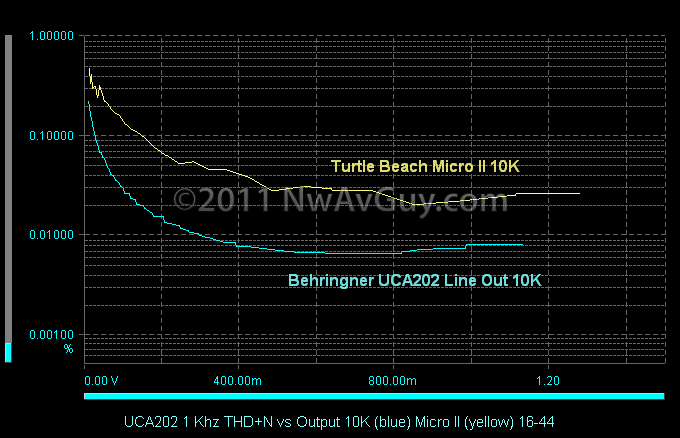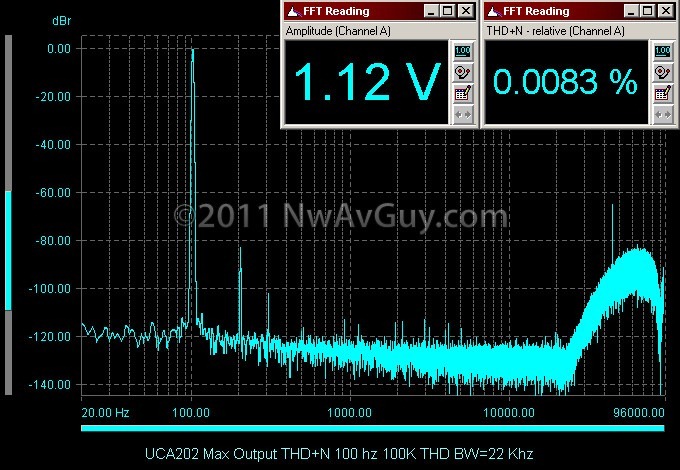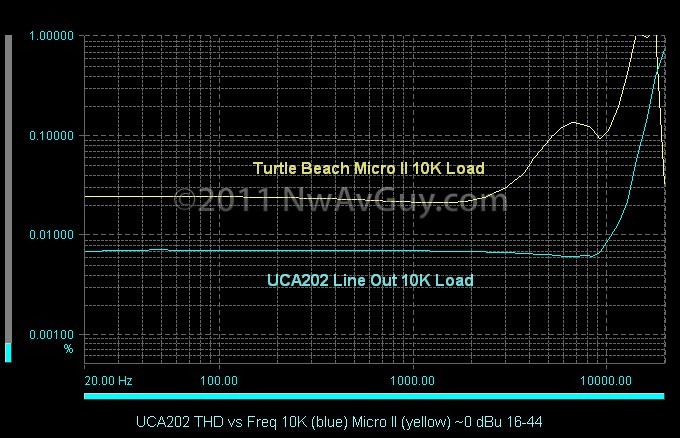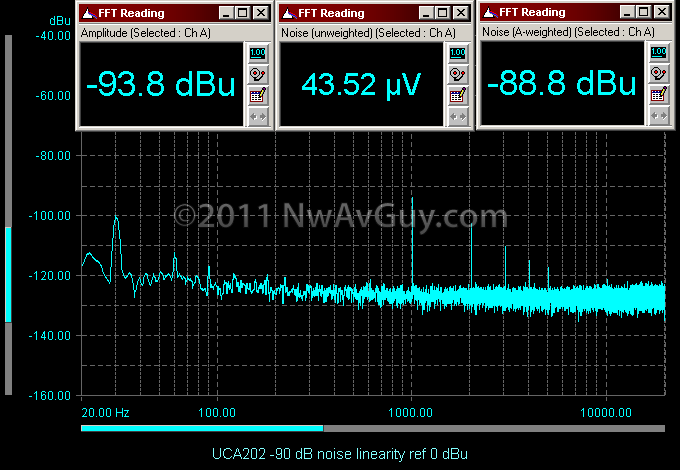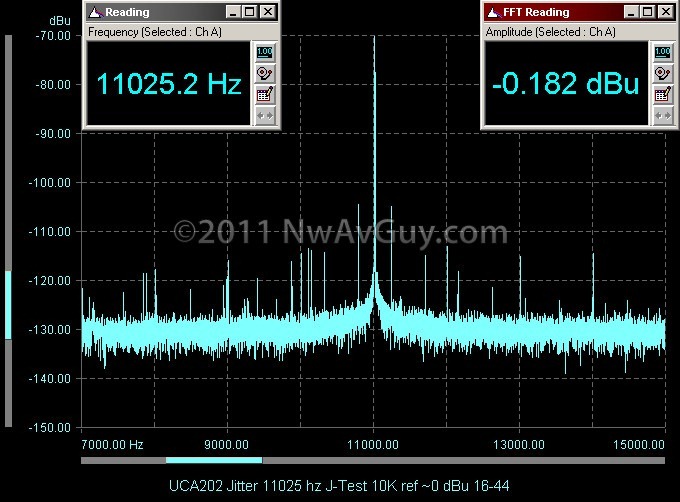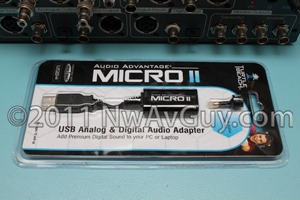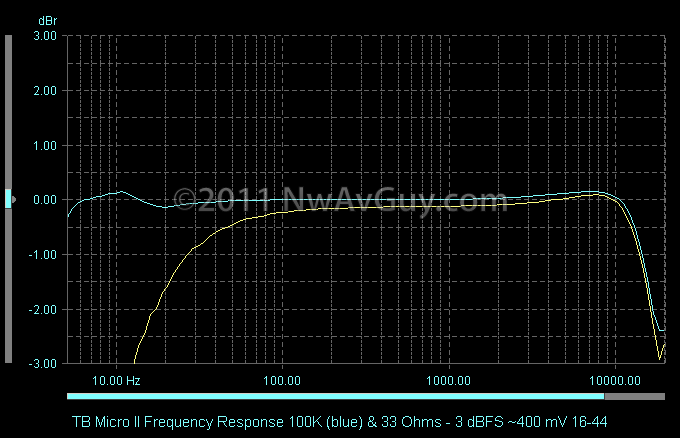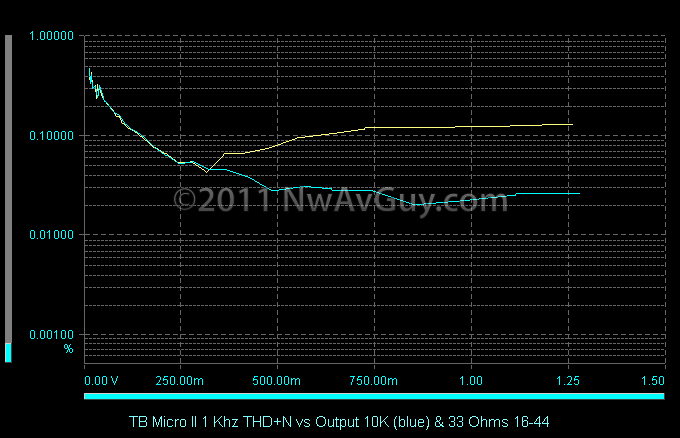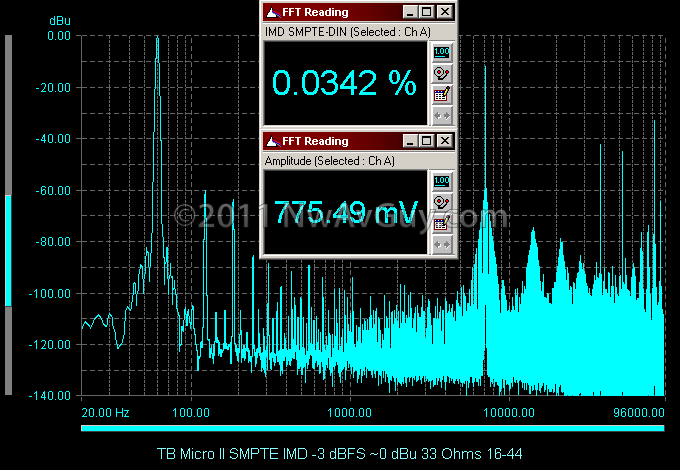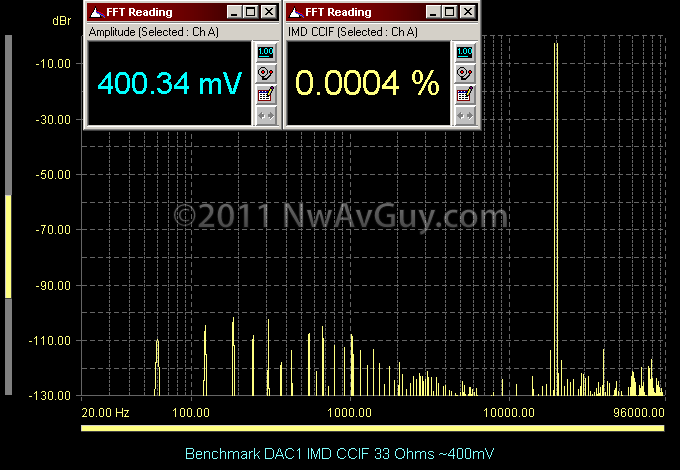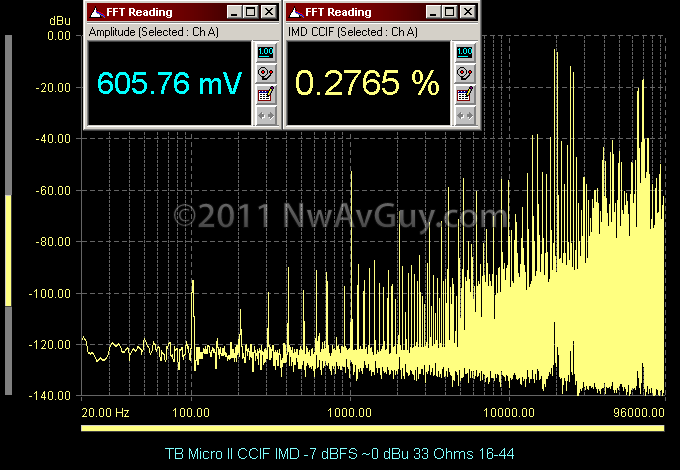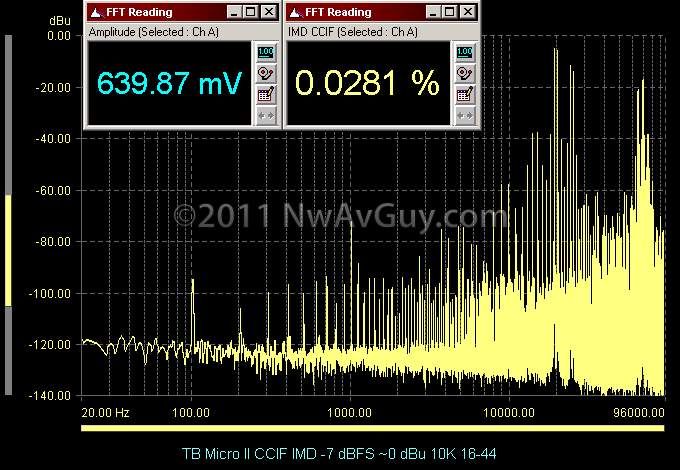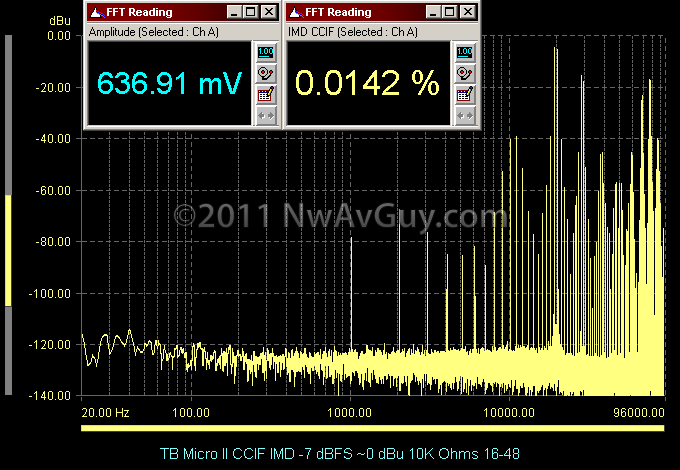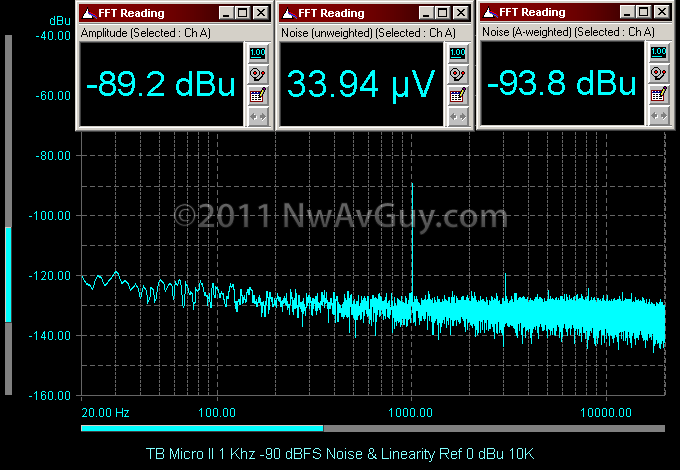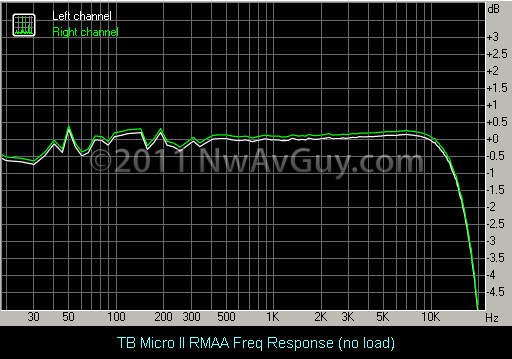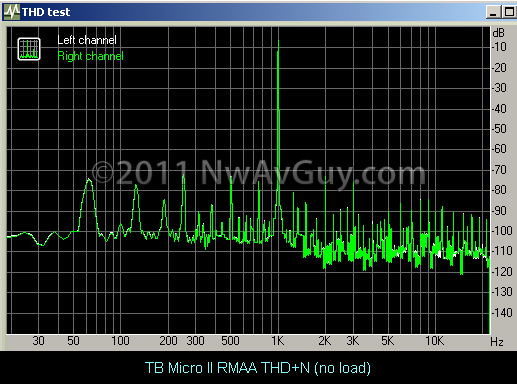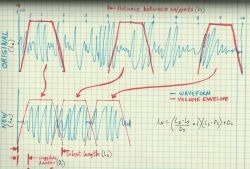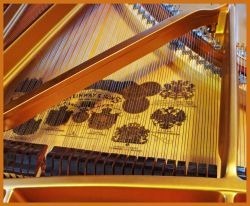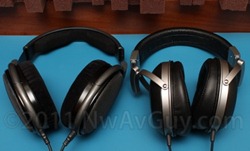
BEHRINGER UCA202: The UCA202 is larger than most newer inexpensive USB DACs (many of which are about the size of a USB thumb drive). The UCA202 is about the size of a deck of cards and has a fairly long (1 meter) attached USB cable. Like the Micro II it has an optical digital TOSLINK output. Unlike most newer inexpensive USB DACs, it also has a volume control but it only affects the headphone output. It has RCA line outputs and inputs.
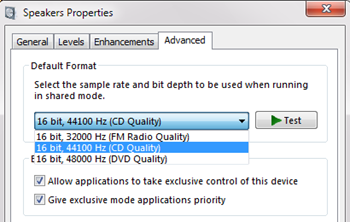 WINDOWS INSTALLATION: The UCA202 installed smoothly in both XP and Windows 7 without needing any drivers. Windows reported it as a “USB Audio CODEC”. Three sample rates are available 32, 44 and 48 Khz all at 16 bits as shown to the right in Windows 7.
WINDOWS INSTALLATION: The UCA202 installed smoothly in both XP and Windows 7 without needing any drivers. Windows reported it as a “USB Audio CODEC”. Three sample rates are available 32, 44 and 48 Khz all at 16 bits as shown to the right in Windows 7.
SUBJECTIVE SOUND QUALITY: Running the UCA202’s line outputs into my 02 headphone amp the sound quality was good with no obvious problems. There was some hiss audible at high gain settings on the amp but at realistic volume/gain settings it was reasonably quiet. Someday I plan to do an ABX blind comparison between the UCA202 and other DACs using the O2 amp.
MEASUREMENT SUMMARY: The overall results are substantially better than the Micro II and mostly quite good for a $29 DAC. The UCA202’s weak areas are noise and low level linearity (and the poor headphone output). To save space and leave room for more columns in future reviews, I’ve replaced my previous “Excellent”, “Very Good”, etc. ratings with a letter grade from A to F where A is excellent and F is Fail (unacceptable).
| Measurement | UCA202 | TB Micro II | FiiO E7 |
| Freq. Resp. 10K | +/- 0.1 dB A | +/- 1.0 dB B | +/- 0.5 dB A |
| Freq. Resp. 33 ohms | N/A | +/- 1.8 dB C | +/- 0.5 dB A |
| HP Output Imp | 47 Ohms D | 0.95 ohms A | 0.13 ohms A |
| Max Output 10K | 1.12 Vrms B | 1.34 Vrms B | 1.87 Vrms B |
| Max Output 33 Ohms | N/A | 1.26 V 52 mW B | 1.4 V 59 mW B |
| THD+N 0 dBFS 10K | 0.008% A | 0.14% C | 0.05% B |
| THD+N 100hz 10K | 0.007% A | 0.025% B | 0.007% A |
| THD+N 1Khz 10K | 0.007% A | 0.02% B | 0.007% A |
| THD+N 1Khz 33ohms | N/A | 0.12% D | 0.015% B |
| THD+N 10Khz 10K | 0.009% A | 0.11% C | 0.007% A |
| IMD CCIF 10K | 0.005% A | 0.028% D | 0.027% C |
| IMD SMPTE 10K | 0.002% A | 0.02% B | 0.008% B |
| Noise A-Wtd | -88.8 dBu C | -93.8 dBu C | -98.7 dBu B |
| -90 dBFS Linearity | 3.8 dB C | 0.8 dB A | 0.0 dB A |
| USB Jitter Jtest | Very Good B | Poor D | Very Good B |
FIRST CLASS:
- Low distortion even at high frequencies.
- Flat frequency response
- Relatively low jitter
- RCA Line Outputs
- RCA Line Inputs can be used for recording
ECONOMY:
- Poor headphone output
- Just over 1 volt RMS maximum output (typical of USB powered DACs)
- Higher than average noise
- Marginal low level linearity
- Flimsy plastic construction
BOTTOM LINE: So far the UCA202 is still the best low cost USB DAC I’ve tested if you don’t use it to drive headphones. I’ll be testing other low cost DACs in the coming weeks to see how they compare. The UCA202 isn’t as small as some newer USB DACs but it’s still relatively portable.
TECH SECTION
TECH INFO: The UCA202 uses the ubiquitous TI PCM2902 integrated USB DAC chip. It’s an old design, but as you’ll see, it easily outperforms the much newer C-Media chip in the similarly priced Turtle Beach Micro II when using the line output. In this case, newer isn't better.
LINE OUT ONLY: I only tested the line outputs as the previous UCA202 review established the 47 ohm headphone output impedance renders it a poor choice for most headphones. Unlike other headphone DACs I’ve tested, you won’t see headphone loads being used in the tests below. All tests were run with a 10K load unless otherwise specified. Please see the original UCA202 review for tests of the headphone output.
FREQUENCY RESPONSE: The frequency response with a 10K load (such as a headphone amp) via the line outputs was substantially better than the TB Micro II. It’s within 0.4 dB from 10 hz to 20 Khz. There are no significant issues here:
THD+N vs OUTPUT: This test starts at 10 mV where noise dominates the measurement. Despite having higher noise than the Micro II, the UCA202 distortion drops much quicker implying it has much less quantization distortion at low levels. Because the UCA202 is likely to be used at line levels with an external amp the distortion will be around 0.01% or even less at typical levels. It has slightly less maximum output (about 1.1 Vrms) compared to the Micro II but much lower overall distortion. The Redbook standard for digital home gear is 2 V rms. But USB powered DACs usually produce around 1 – 1.5 Vrms:
THD+N 100 hz 0 dBFS: With the PC volume at maximum, and a 0 dBFS input, the UCA202 produces about 1.1 Vrms at very low distortion. This is excellent performance with all harmonics below the magic –80 dB threshold. Way out of band you can see a spike at the 44 Khz sampling frequency which is fairly normal—especially in low cost DACs. The odd bump in the noise floor above 20 Khz is related to intentional noise shaping in the PCM2902 DAC. It’s an intentional design technique to lower noise within the audio band:
THD+N vs FREQUENCY: Here’s the THD+Noise plotted from 20 hz to 20 Khz into 10K (blue) at 775 mV (0 dBu). The Micro II is shown, for comparison, in yellow. The input is –3 dBFS to prevent any digital overload of the DAC. The UCA202 does much better here staying below the ideal 0.01% threshold until about 11 Khz. This is very good performance for a wideband test:
SMPTE IMD: This an excellent result with essentially no IMD products and everything well below –80 dB. In comparison, the Micro II had 170 times more distortion on this test:
CCIF IMD 44 Khz: The UCA202 does extremely well here for an inexpensive DAC with more than 50 times less distortion than the Micro II at the same level into the same 10K load. More important, all distortion products in the audio band are well below –80 dB. The two spikes around 25 Khz are a little alarming but only your dog might hear them. See the Micro II review CCIF section for both it’s very poor performance on this test and the DAC1’s reference plot. This is excellent for any reasonably priced DAC running at 16/44:
CCIF IMD 48 Khz: The UCA202 also does well, although slightly worse, at 48 Khz:
NOISE & LINEARITY: The UCA202 is only average for noise and worse than average for linearity. A –90 dBFS signal is reproduced at –93.8 dB for an error of 3.8 dB. There’s less than 1 dB of error at –80 dBFS so the problem is limited to extremely low levels. Noise referenced to my old 400 mV dBr reference would be 83.1 dB and against full output it’s 91.8 dB both A-Weighted. The good news is the noise will be upstream of the volume control if an external amp like the O2 is used and the PC volume is set to maximum. That means you’ll get around 90 dB of real world S/N ratio which is sufficiently quiet. But if you plan to use the PC’s volume control, the noise and/or linearity might be an issue in some circumstances. The spikes at 2, 3, 4 and 5 Khz are likely quantization distortion of the 1 khz low level signal and are relatively typical. I don’t know what’s responsible for the spike at 30 hz but it’s very inaudible.
JITTER: Here’s the spectrum from the dScope’s J-Test for jitter. The two things to look for are the number and level of symmetrical sidebands and the “spread” at the base of the 11025 hz signal. Compare the result below to the Micro II’s Jitter to see how much better the UCA202 does. This is a very respectable result for an inexpensive USB DAC and the frequency accuracy (clock accuracy) is very good as shown by the frequency reading on the left:
TECH COMMENTS: Used to drive an amp, powered speakers, or other source with a line input, the TI PCM2902 based UCA202 blows away the Turtle Beach Micro II based on the C-Media CM102. The only weak areas are the noise and linearity below –80 dBFS. But neither of those is likely to be an issue if you leave the PC volume all the way up and use the volume control on the amp/speakers.

